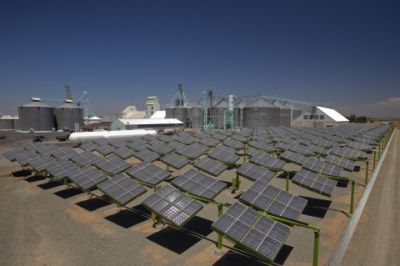GreenVolts powers up Van Dyke’s Rice Dryer facility
 Facing double-digit electric rate increases and having a constrained space, Van Dyke’s Rice Dryer in Pleasant Grove, Calif., was looking for a way to control its electric costs. After looking around at its options, the company chose a 464 kilowatt GreenVolts concentrating photovoltaic array (CPV). The array was recently completed and now provides 100 percent of the facility’s electric needs.
Facing double-digit electric rate increases and having a constrained space, Van Dyke’s Rice Dryer in Pleasant Grove, Calif., was looking for a way to control its electric costs. After looking around at its options, the company chose a 464 kilowatt GreenVolts concentrating photovoltaic array (CPV). The array was recently completed and now provides 100 percent of the facility’s electric needs.
The facility processes roughly 160 million pounds of rice a year and all the processing, cleaning, and drying of rice. All those processes consume a lot of electricity. “Our electric power is probably 22 percent to 23 percent of our cost of operation,” said company Owner Jim Van Dyke. The cost of electricity has risen on an annual basis by between 5 percent and 6 percent. “They’re telling us it’s going to go up by double digits. If we don’t get a handle on this we’re going to go out of business.”
The warehousing facility had some additional issues, like constrained space. They only had about 4 acres of land for the project. While other solar technologies would have taken roughly 10 acres to provide the facility’s power, GreenVolts’ CPV systems were provide the power within the space constraint, according to Van Dyke.
“The system was designed to offset all or nearly all of the usage at the plant using the limited land area available,” said GreenVolts Co-Founder and Vice President of Strategic Development Eric Romo. “Of course, the exact amount of solar produced annually may fluctuate with the weather, and the electricity required at Van Dyke’s Rice Dryer will change with yearly variations in the rice crop and the amount and mix of the services they provide,” he said.
The GreenVolts system and other CPV systems offer similar watts per square meter densities, which are higher than those of other solar PV systems like thin-film or silicon PV, both of which have lower conversion efficiencies. “GreenVolts has several advantages that help lower the cost of energy over the life of the project. For example, our system is a modular and preassembled system, and does not require heavy equipment or special training, making installation faster and less costly,” Romo said.
Some other traits of the GreenVolts system, including stowing modules face-down at night and a distributed inverter architecture help ensure efficiency, according to Romo. Stowing upside down at night reduces condensation and soiling, while the inverters allow the arrays to work independently, generating more power overall.
The installation took between 2 and 3 months, according to Romo. He added that it took longer than expected because of weather delays.



